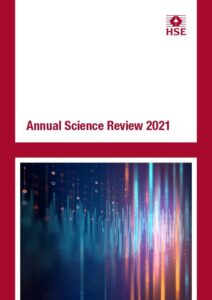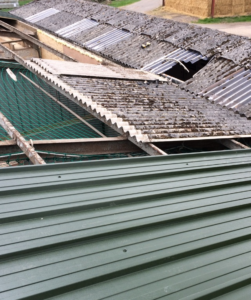HSE is proud to publish this year’s Annual Science Review: ‘COVID-19: Collaboration in a time of crisis’
HSE’s Annual Science Review 2021 has been launched, focusing on ways science and evidence is being used to prevent death, injury and ill-health in Great Britain’s workplaces.

The Review illustrates how our robust scientific evidence has been supporting the government’s response to the pandemic. We look at HSE’s contribution to the evolving global evidence base and the routes we have used to share that knowledge, including:
- Work to support the rapid increase in supply of suitable PPE to the NHS front line
- Biosafety training in relation to COVID-19, including for workers handling bulk quantities of live virus for vaccine research
- Enabling additional hand sanitisers to reach the market quickly
- Developing an understanding of transmission through computational fluid dynamics simulations.
- Supporting and informing the Scientific Advice to Government in Emergencies (SAGE) response to COVID-19
The review also highlights the range of studies HSE scientists are working on to support healthy and safe work in Great Britain, including:
- The safe introduction of hydrogen technologies and supporting the UK target to achieve net zero emissions
- Assessing the evidence for safe levels of exposure to toxicological hazards
- The evidence supporting an award-winning campaign that reduced the risk of Legionnaires’ disease outbreaks
- Supporting industry on a commercial basis, such as using our world class experiment facilities to test the heat resistance of components for jet engines
HSE’s Chief Scientific Adviser and Director of Research, Professor Andrew Curran, said:
“We are proud of the impact our science has had on keeping people and work environments healthy and safe.
“It is difficult to pick any particular highlights. However, in terms of sheer scale, I am particularly impressed by the work our technical experts have been doing to ensure that any personal protective equipment that enters the supply chain in Great Britain will protect the person who wears it.
“During these difficult times, it is easy to forget that many businesses continued to operate with COVID-secure measures in place.
“While Great Britain remains one of the safest places to work in the world, unfortunately workplace incidents have still occurred. We have continued to carry out forensic incident investigation, having ensured that our science and research facility in Buxton is COVID-secure.”

HSE’s Buxton Science and Research Facility from the Air
The HSE Annual Science Review is available at https://www.hse.gov.uk/research/review.htm
Notes to Editors:
- The Health and Safety Executive (HSE) is Britain’s national regulator for workplace health and safety. We prevent work-related death, injury and ill health through regulatory actions that range from influencing behaviours across whole industry sectors through to targeted interventions on individual businesses. These activities are supported by globally recognised scientific expertise. hse.gov.uk
- More about the legislation referred to in this case can be found at: legislation.gov.uk/
- HSE news releases are available at http://press.hse.gov.uk
- HSE is a scientific and evidence based organisation and employs over 850 scientists, engineers, physicians and analysts. It is recognised as one of the world’s leading providers of health and safety solutions to industry, government and professional bodies.
- HSE Annual Science Review are available here: https://www.hse.gov.uk/research/review.htm
- Follow HSE Science on twitter @CSA_HSE
The post HSE is proud to publish this year’s Annual Science Review: ‘COVID-19: Collaboration in a time of crisis’ appeared first on HSE Media Centre.
